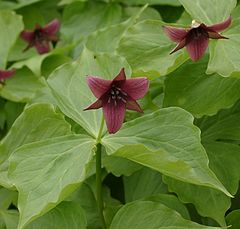Trillium erectum
| Trillium erectum subsp. var. | Bethroot, Birthroot | |||||||||||||||||||||||||||||||||||||||||||||||||||||||
|---|---|---|---|---|---|---|---|---|---|---|---|---|---|---|---|---|---|---|---|---|---|---|---|---|---|---|---|---|---|---|---|---|---|---|---|---|---|---|---|---|---|---|---|---|---|---|---|---|---|---|---|---|---|---|---|---|

|
|
| ||||||||||||||||||||||||||||||||||||||||||||||||||||||
| ||||||||||||||||||||||||||||||||||||||||||||||||||||||||
Trillium erectum, also known as Wake-robin, red trillium, purple trillium, Beth root or Stinking Benjamin, is a spring-flowering perennial plant native to the east and north-eastern areas of North America. The flowers are a deep red colour, and the plant takes its name Wake-robin by analogy with the Robin, which has a red breast that heralds spring.
This plant grows to about 40 cm in height with a spread of 30 cm and can tolerate extreme cold in winter, surviving temperatures down to -35 C. The flowers have the smell of rotting meat, as they are pollinated by flies. The leaves contain calcium oxalate crystals and crystal raphide, and should not be consumed by humans.
| Standard Cyclopedia of Horticulture |
|---|
|
Trillium erectum, Linn. (T. pendulum, Willd. T. purpureum. Kin. T. foetidum, Salisb. T. atropurpureum, Curtis). Stout, 1 ft. or more high: lvs. broadly rhombic-ovate: pedicel usually bent over or inclined but sometimes erect: fls. brown-purple to greenish purple, the petals usually about 1 in. long, ovate to lanceolate, not much if any exceeding the sepals. Nova Scotia to Man., N. C. and Mo.—The fls. of T. erectum are ill-smelling. Var. album, Lodd., has white fls. Var. viridiflorum. Hook. Fls. greenish. Not known to be in the trade. CH
|
Cultivation
- Do you have cultivation info on this plant? Edit this section!
Propagation
- Do you have propagation info on this plant? Edit this section!
Pests and diseases
- Do you have pest and disease info on this plant? Edit this section!
Species
Gallery
References
- Standard Cyclopedia of Horticulture, by L. H. Bailey, MacMillan Co., 1963
External links
- w:Trillium erectum. Some of the material on this page may be from Wikipedia, under the Creative Commons license.
- Trillium erectum QR Code (Size 50, 100, 200, 500)

